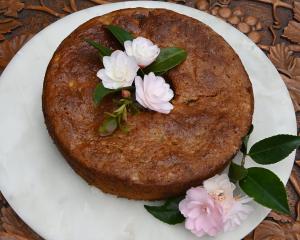
Elien Lewis has a ‘‘root to tip’’ philosophy when it comes to cooking.
This is because she likes to grow organically in her back yard whatever her family can eat as part of creating a low carbon footprint and minimal waste.

She is well aware of the challenges people can face with a suburban garden, so in her book Homegrown Happiness — a Kiwi guide to living off the suburban land she provides advice to help people develop their own vegetable gardens, what to plant, when, whatever the climate, how to establish a working compost bin and keeping the pests at bay.
Lewis, who also blogs about her endeavours and shows her garden journey on Youtube, is also a keen cook and baker.
She enjoys transforming what she grows into healthy recipes her whole family love.
‘‘This is where my creativity flourishes. I love to create recipes, write about food and photograph the finished products. I’m a rustic-style cook, using what ever I’m currently growing in the garden.’’
Due to the size of her garden, she only grows what they need, so she uses the ‘‘root to tip’’ philosophy to stretch what she grows by using as much of the fruits and vegetables as possible.
‘‘Less peeling and discarding ‘ugly’ pieces (and in an organic garden, there can be a lot ‘imperfect’ veges!) I love finding creative ways to use up parts of fruits and vegetables that are so often discarded.’’

This is a delicious, comforting soup for when the colder autumn evenings arrive. The sweetness of the carrot pairs beautifully with the warming kick of ginger.
My secret ingredients are a dab of miso paste for a rich umami flavour and, when served, a sprinkle of salty tamari seeds on top. Make sure you don’t throw away the greens from your homegrown carrots, though. They are perfect to dry and turn into homemade bouillon stock powder.
Serves 4-6 (Vegan / gluten free)
Tamari seeds
1 cup sunflower seeds
3 Tbsp sesame seeds (I use a mixture of black and white)
2 Tbsp tamari (or soy sauce, or coconut aminos)
1 tsp olive oil
Carrot and ginger soup
2 Tbsp olive oil
1 large onion, peeled and finely diced
600g washed carrots, greens removed
3 cloves garlic, peeled and crushed
1 and 1/2 Tbsp fresh ginger, grated
1/2 tsp turmeric powder
1 tsp cumin powder
1/4 tsp chilli flakes (optional)
4 cups /1 litre vegetable stock
1 Tbsp miso paste
To serve
yoghurt
Method
Preheat the oven to 160degC (or 140degC fan bake).
In a bowl, toss together the sunflower and sesame seeds, tamari and olive oil. Spread the seeds in a single layer on a baking tray.
Bake for 10-15 minutes until toasted through, taking care they don’t burn. Remove from the oven and set aside.
Heat a large soup pot over medium heat and add oil and onion. Saute the onion for 5 minutes until translucent.
Meanwhile, chop the carrots into 2cm chunks.
Add in the garlic, ginger and spices to the pot and cook for a further 2 minutes before adding in the carrots. Saute the carrots for another 2 minutes before adding the vegetable stock and miso paste.
Bring the soup to a simmer and cook until the carrots are tender. Remove from the heat, then blitz the soup in a blender until smooth and creamy.
Serve with a sprinkle of tamari seeds and a dollop of yoghurt. Any unused seeds can be stored in an airtight container.

Kumara gnocchi with a buttery white wine sauce
Sweet , light kumara gnocchi in a fragrant wine sauce is the ultimate winter comfort meal. These pillowy kumara dumplings can be made ahead of time and kept refrigerated for up to two days before cooking. Alternatively, once cooked they can be frozen for later use.
Serves4 (Vegetarian / nut free)
Gnocchi
500g kumara
250g ricotta cheese, drained
¼ cup parmesan cheese, finely grated
¼ tsp ground nutmeg
1 tsp salt
1 cup/150g white flour (plus extra for dusting)
1 to 3 Tbsp olive oil
White wine sauce
3 Tbsp butter
2 cloves garlic, peeled and crushed
2 Tbsp fresh thyme, chopped
½ cup/125ml white wine
¼ teaspoon salt
cracked black pepper to taste
To serve
parmesan cheese, grated
fresh thyme
Method
Preheat the oven to 200degC (or 180degC fan bake).
Pierce a few holes in the kumara with a fork, then bake until completely soft inside. Alternatively, the kumara can be microwaved until soft, about 4-5 minutes on one side, then another 2-3 minutes on the other side.
Once cooked, peel the kumara while still hot and discard the skins. Mash until smooth, then mix in the ricotta, parmesan, nutmeg and salt and combine well. Add in the flour and knead together gently until just combined into a dough ball. It should be soft and slightly sticky. Tip the dough on to a well-floured bench and divide it into four even-sized pieces.
Gently roll out one piece at a time into a long rope of about 2½cm thickness. Cut the rope into 2cm pieces. Place each piece on a flour dusted board or tray and ensure the gnocchi aren’t touching each other. Continue with the remaining dough.
At this stage, the gnocchi can be refrigerated until needed or used straight away.
Bring a large pot of water to the boil. Once boiling, add in a pinch of salt and gently lower in one-third of the gnocchi pieces. Cook the gnocchi until they rise to the top of the pan, then use a slotted spoon to remove them and let them drain. Continue with the rest of the gnocchi.
In a frying pan over medium heat, heat 1 tablespoon oil. Fry the gnocchi in batches so they are crispy on each side (1-2 minutes each side) with more oil as needed. Once they’re fried, place them on a plate and start on the sauce.
To make the sauce, heat the same frying pan over medium heat and add in the butter and the garlic. Fry until the butter begins to lightly brown, then add the fresh thyme, white wine, salt and pepper.
Simmer the sauce for 4-5 minutes until slightly reduced, then return the gnocchi to the pan. Coat with the sauce and warm through.
Serve hot with extra parmesan and chopped thyme.

Poached pear tart
This tart features delicate poached pears in a sweet frangipane filling, encased in a tender butter pastry. It has simple and balanced flavours that make for a delicious and rather refined dessert. The pears are poached in a flavourful spiced liquid, which can be retained and used as a tasty syrup in drinks or for poaching and preserving other fruits.
Serves 8
Poached pears:
¾ cup/170g sugar
1 cinnamon stick /1 tsp ground cinnamon
2cm fresh ginger, thinly sliced
⅛ tsp salt
1 small lemon
3 medium pears
Pastry:
1½ cup/225g white flour
1 Tbsp white sugar
1 Tbsp lemon zest
⅛ tsp salt
120g cold butter, diced
1 egg yolk (reserving the white for later)
cold water
Frangipane filling:
100g butter, room temperature
⅛ tsp salt
½ cup/110g white sugar
2 eggs + egg white reserved earlier
1 cup/100g ground almonds
1½ Tbsp white flour
½ tsp almond extract
Method
Fill a medium-sized saucepan with 1½ litres of water, the sugar, cinnamon, ginger and salt. Bring to a simmer, stirring until the sugar has dissolved.
While the water is heating, peel the pears and scoop out the pear cores from the bottom using a teaspoon. Chop the lemon into 4 pieces.
Add the pears and the lemon into the simmering water and cook the pears for 8-9 minutes, flipping them halfway through.
Remove the pan from the heat. Leave the pears to cool in the liquid and start on the pastry.
In a bowl, add the flour, sugar, lemon zest, salt and butter. Use a pastry cutter to cut the butter into small granules resembling coarse breadcrumbs. Add in the egg yolk and use a fork to combine it, along with 1 tablespoon of cold water at a time until it forms a stiff dough.
Refrigerate the dough for at least 30 minutes.
Preheat the oven to 200degC (or 180degC fan bake). On a lightly floured bench, roll the dough out into a large circle and gently press it into a 23cm tart tin. Prick the pastry a few times with a fork. Place a sheet of baking paper on top of the pastry dough and some baking weights (or dried rice) to hold the paper down. Bake the pastry for 12 minutes. After 12 minutes, remove the baking paper and weights and bake for a further 3 minutes.
Remove from the oven and set aside to cool.
While it is cooling, start the frangipane filling. In a mixing bowl, add the butter, salt and sugar. Beat together until pale and fluffy. Add 1 egg and one-third of the ground almonds and beat well, then repeat with the remaining egg and almonds then add the flour and almond extract.
Once the pears have cooled, remove them from the poaching liquid and let them drain on a chopping board. Slice each pear in half, then each half into 5-6 slices, keeping them together in the pear shape.
Spread the frangipane filling in the bottom of the pastry base. Arrange the pear halves on top and lightly press them into the filling.
Lower the oven temperature to 190degC (or 170degC fan bake) and bake the tart for 40-45 minutes or until the centre of the tart is cooked. Remove it from the oven and let it cool before dusting with icing sugar and serving.












